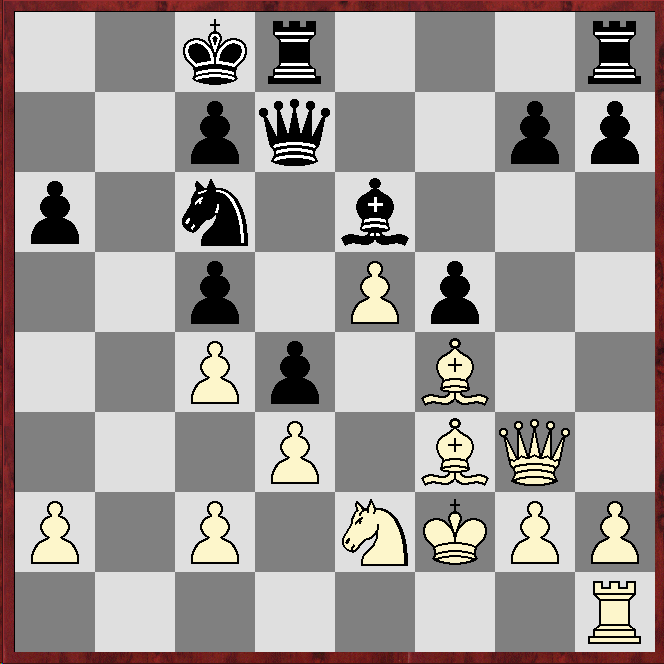But there is a big difference between knowing an idea and successfully implementing it over the board.
One of the hardest positional motifs for club players, I believe, is the exchange sacrifice.
That is why I was pleased - perhaps inordinately so - with the positional exchange-sacrifice I carried off in round six at Cambridge.
The following game, taken from 500 Master Games Of Chess by Savielly Tartakower and Julius du Mont, helps in trying to understand such sacrifices.
Notes in italics are algebraicised from the book.
Munich Olympiad 1936, Czechoslovakia v Yugoslavia
Vienna Gambit
A beautiful game in the modern style, in which the strategy of the blockade, helped by a first sacrifice of the exchange, followed near the end by another, is entirely successful.
1.e4 e5 2.Nc3 Nf6 3.f4 d5 4.fxe5
The most energetic continuation.
4...Nxe4
*****
*****
*****
*****
5.Qf3!?
An old continuation, favoured by Paulsen, but the usual 5.Nf3 is more natural.
An instructive "opening trap" is 5.d3, after which the plausible 5...Qh4+ 6.g3 Nxg3 7.Nf3 Qh5 8.Rg1 leads to Black's discomfiture, but the rational continuation 5...Nxc3 6.bxc3 d4 7.Nf3 c5 leaves Black with a very comfortable game.
Something strange has happened here, as 8.Rg1?? is a gross blunder - Black simply captures on f1. However 8.Nxd5 is another matter, although even this is not clear, eg the largely forcing ...Nxh1 9.Nxc7+ Kxd8 10.Nxa8 Bg4 11.Bg2 Nc6 12.d4 f6!? (this suggestion of Stockfish16 and Komodo14.1 may be a novelty) 13.Be3 fxe5 14.dxe5+ Kc8 gives Black full compensation for a pawn, according to the engines.
*****
*****
*****
*****
5...f5!?
This is Stockfish16's top choice; Komodo14.1 prefers 5...Nc6!? More popular than these two moves combined, in ChessBase's 2024 Mega database, is 5...Nxc3.
6.d3
He decides to rid himself of the intruding knight without delay, as after 6.Nge2 Nc6 7.d4 Nb4 8.Kd1 c5 Black takes the lead.
6...Nxc3 7.bxc3 d4
More enterprising than 7...Be7 8.d4, which would round off White's game nicely.
8.Qg3
This very ingenious continuation in the gambit style improves White's chances, which would be far less propitious after 8.Be2 Nc6 etc, to say nothing of 8.cxd4 Qxd4 etc.
8...Nc6 9.Be2 Qd5
If 9...Be6, 10.Rb1.
The engines strongly dislike Rb1, claiming 10...dxc3 gives Black at least the upper hand. They suggest 10.c4 (Stockfish16) or 10.Bf3 (Komodo14.1).
10.Bf4!?
Methodical play. Another conception is 10.Bf3 Qxe5+ 11.Qxe5+ Nxe5 12.cxd4 Nxf3+ 13.Nxf3 with a fine centre, or 10...Qc5 11.Ne2 Nxe5 12.0-0, and White gives up worldly possessions for an attack.
Hromádka won with 10.Bf3 against František Treybal in 1912 and Heinrich Wolf in 1923. The text seems to have been a novelty.
10...Be6 11.c4!? Bb4+ 12.Kf2
The game being a closed one, the king is perfectly safe here.
12...Qd7 13.Rb1 0-0-0!?
He hopes to mount an attack on the kingside, but 13...0-0 affords greater resistance.
The engines marginally prefer the text.
14.Bf3 Bc5 15.Rb5 b6 16.Ne2 a6
*****
*****
*****
*****
17.Rxc5!
A fine "positional sacrifice."
The engines agree the text is best, but in a way it is also forced as 17.Rbb1 Bxc4! is very good for Black. Be that as it may, what, after ...
17...bxc5
... does White have for the exchange?
*****
*****
*****
*****
In purely material terms, White has a dark-square bishop for a rook. That means White has the bishop-pair, and, speaking generally, the bishop-pair plus a pawn is reckoned to give fair compensation for the exchange. Clearly White does not have enough compensation, materially, here. However, positionally, White's game is much more promising. Despite having only one rook, it is White who is likely to benefit most from the only open file. White's light-square bishop is also much more active than its black counterpart, and these two factors combined mean the black king is less-safe than White's. Nevertheless, Black has an obvious plan for a kingside attack, so the game is far from a foregone conclusion.
18.Rb1 Rdg8 19.h4!?
An important move, preventing 19...g5, and foreshadowing White's plan of establishing a blockade.
19...Nd8
He thinks he can oppose the enemy's aspirations by peaceful means, for the ruthless 19...g5 20.hxg5 h6 21.g6 h5 would require too much self-denial. But shutting the stable door after the horse is gone is nothing unusual.
Perhaps 19...h6 is better, although the engines prefer White after 20.h5.
20.Bg5 Qa4?
The engines suggest 20...Nc6!?, but reckon White is on top.
21.Rb2
Even stronger is the engines' 21.Bxd8 Kxd8 22.Qg5+.
21...Nf7
If 21...Qa3, 22.Bc1.
22.Nf4
The knight is out to eliminate Black's best defensive piece.
22...Qe8 23.Nxe6 Qxe6 24.Bd5 Qg6
24...Qxe5 can be successfully met by 25.Bxf7 or 25.Bf4.
25.e6 Nd6 26.Qe5
In order to be able to play 27.Be7 without exchanging queens. The blockade of Black's position is worthy of note.
26...Re8
*****
*****
*****
*****
27.Rb6! 1-0
A beautiful final stroke, intended to eliminate Black's last defender.





No comments:
Post a Comment